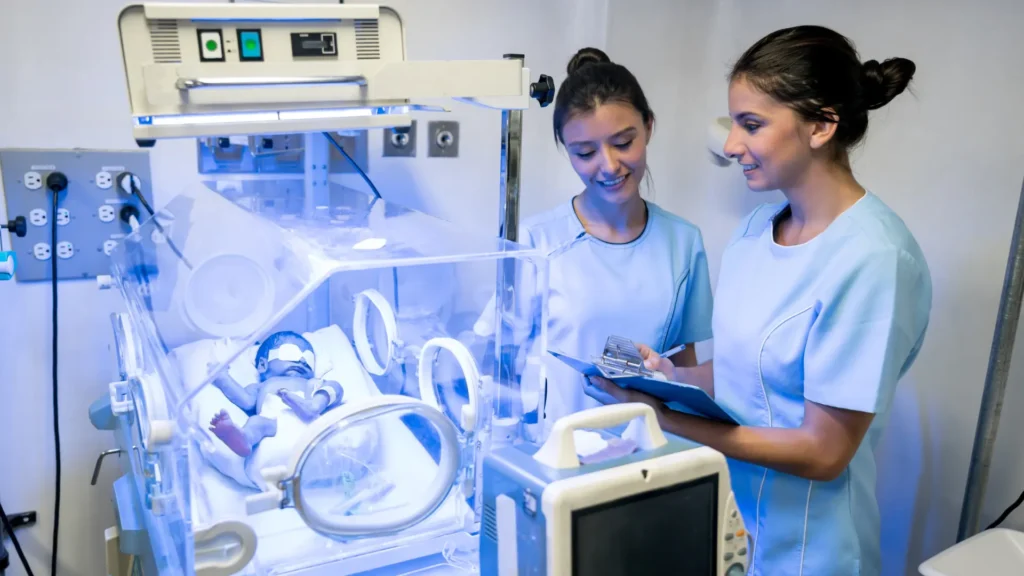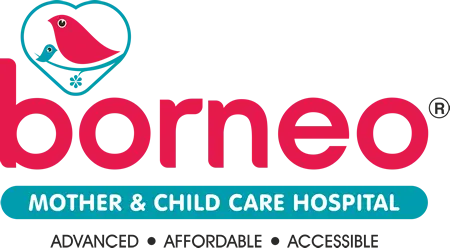One of the first things many new parents notice in the days after welcoming their baby is a yellowish tinge to their little one’s skin and eyes. This condition, known as Newborn Jaundice, is extremely common and often a source of considerable anxiety. “Is it normal?” “Is my baby okay?” “What should I do?” – these are questions my team and I hear every day.
I’m Dr. Santosh Madrewar, Senior Paediatrician and Founder of Borneo Hospital. With our dedicated paediatric and neonatal units across Thane, Nashik, Chhatrapati Sambhaji Nagar, and Raipur City, caring for newborns is our special privilege. I want to reassure you that in most cases, Newborn Jaundice is a normal, temporary condition. However, it always requires careful observation and professional monitoring to ensure your baby’s well-being.
This article aims to demystify Newborn Jaundice for Indian parents. We’ll explain what it is, why it happens, how to recognise the signs, when it’s considered normal, when it needs medical attention, and how it’s treated effectively. Our goal is to replace your worry with clear, factual information so you can care for your baby confidently.
What is Newborn Jaundice? (The Science Explained Simply)
Newborn Jaundice is the yellow discolouration of a baby’s skin and the whites of their eyes (the sclera). It’s not a disease in itself, but a visible sign of a substance called bilirubin building up in the blood.
- What is Bilirubin? Bilirubin is a yellow pigment that the body naturally creates during the normal process of breaking down old red blood cells. The liver is responsible for processing this bilirubin so it can be removed from the body, primarily through stool.
- Why is Jaundice So Common in Newborns? There are two main reasons:
- Babies are born with a higher number of red blood cells, and these cells have a shorter lifespan than ours, so they break down more quickly, producing more bilirubin.
- A newborn baby’s liver is still immature and not yet fully efficient. It can’t process the excess bilirubin as quickly as needed.
This temporary imbalance between bilirubin production and the liver’s ability to clear it away cause the bilirubin levels to rise in the blood, leading to the yellow appearance we call Newborn Jaundice.
Types of Newborn Jaundice: What’s Normal and What’s Not?
It’s helpful to know that there are different types of jaundice.
1. Physiological Jaundice (The Most Common & ‘Normal’ Type):
This is the mild jaundice seen in the majority (over 60%) of healthy, full-term newborns.
Timing: It characteristically appears after the first 24 hours of life, usually becoming noticeable on day 2 or 3. It typically peaks in intensity around day 4-5 and then gradually disappears on its own within one to two weeks as the baby’s liver matures.
Message: This type of Newborn Jaundice is a normal part of a baby’s transition to life outside the womb and usually requires no treatment other than continued frequent feeding and careful monitoring by your paediatrician.
2. Pathological Jaundice (Jaundice Requiring Medical Attention):
This type is less common but more serious as it might signal an underlying medical issue causing bilirubin to rise much higher or faster than normal.
Potential Causes: Common causes include a blood group incompatibility between the mother and baby (e.g., Rh or ABO mismatch), significant bruising during birth, certain infections, prematurity, or underlying issues with the baby’s liver or specific enzyme deficiencies (like G6PD deficiency, which is relevant in some Indian communities).
3. Breastfeeding Jaundice vs. Breast Milk Jaundice (A Common Point of Confusion):
Breastfeeding Jaundice: This occurs in the first week of life and is often related to the baby not getting enough milk yet. This can be due to latching difficulties or a delay in the mother’s mature milk coming in. Fewer calories and less hydration leads to fewer bowel movements, so bilirubin isn’t excreted effectively. The solution is to improve breastfeeding with lactation support, not to stop breastfeeding.
Breast Milk Jaundice: This type starts after the first week and can sometimes last for several weeks. It occurs in perfectly healthy, thriving, breastfed babies who are gaining weight well. It’s thought to be caused by a substance in some mothers’ milk that affects how the baby’s liver processes bilirubin. It is harmless. Breastfeeding should absolutely be continued.
Recognising the Signs of Jaundice in Your Baby
- Visual Signs: The most obvious sign is the yellowing of the skin and the whites of the eyes.
- Progression: Jaundice usually starts on the face and then, as bilirubin levels increase, it appears to spread downwards to the chest, abdomen, arms, and finally the legs and feet.
- How Parents Can Check at Home: Check your baby in good, natural daylight (near a window). Gently press one finger on your baby’s forehead, nose, or chest. When you lift your finger, if the skin looks yellow where you pressed, jaundice is present.
- Other Potential Signs: If jaundice levels become higher, the baby might become increasingly drowsy, sleepy, or difficult to wake for feeds. They might also feed poorly or have a high-pitched cry.

When to Call Your Paediatrician: Knowing the Red Flags
While most Newborn Jaundice is normal, some signs require prompt medical evaluation. Trust your parental instincts. If you are worried about your baby, it is always the right decision to contact your paediatrician at Borneo Hospital.
Seek Medical Advice PROMPTLY If:
- Jaundice appears within the first 24 hours of life. (This is always a sign that needs immediate medical assessment).
- The jaundice seems to be spreading rapidly down the body or becoming more intense (the skin looks deep yellow or orange).
- Your baby has a fever (rectal temperature of 100.4°F / 38°C or higher).
- Your baby is very difficult to wake up, seems unusually sleepy, lethargic, or limp/floppy.
- Your baby is not feeding well (has a poor suck, refuses feeds) or is showing signs of dehydration (e.g., fewer than 4-6 heavy wet nappies in 24 hours).
- Your baby is making an unusual high-pitched, shrill cry or is arching their neck or body backwards.
- Your baby’s stools become pale, chalky white, or grey (normal breastfed stool is yellowish; formula-fed is often tan/brown).
- Your baby’s urine is persistently dark yellow or brown (normal newborn urine should be pale or colourless).
- The jaundice continues for more than 3 weeks.
Diagnosis and Treatment of Newborn Jaundice at Borneo Hospital
When you bring your baby in with concerns about jaundice, we follow a clear process.
Diagnosis & Monitoring:
Visual Assessment: An initial check is performed by our experienced paediatricians and nurses.
Transcutaneous Bilirubinometer (TcB): For screening, we often use a special device that is gently placed on your baby’s skin. It measures the yellowness of the skin to give a reliable estimate of the bilirubin level without needing a blood test. It’s quick and painless.
Blood Test (Serum Bilirubin – SBR): If the TcB reading is high or there are other clinical concerns, a blood test (usually from a small heel prick) is done to get the precise bilirubin level in the blood. This is the gold standard for diagnosis and for making treatment decisions.
Treatment Options:
1. Phototherapy (The “Blue Lights”):
This is the most common, safe, and highly effective treatment for elevated Newborn Jaundice.
What it is: Your baby is placed in a cot or incubator, wearing only a nappy and special protective eye shades. They are placed under special blue-green spectrum lights.
How it works simply: The specific wavelength of light is absorbed by your baby’s skin. This light energy changes the structure of the bilirubin molecules into a different form that is water-soluble. This means the body can then easily excrete it in urine and stool, helping to lower the bilirubin level in the blood.
Reassurance: At Borneo Hospital, we use modern, high-intensity phototherapy units to provide efficient and safe treatment. We ensure your baby stays hydrated and well-fed throughout the process, as frequent feeding is crucial to help flush out the bilirubin.
2. Other Treatments (For Severe or Specific Cases):
Intravenous Immunoglobulin (IVIG): In some cases of severe jaundice caused by blood group incompatibility between mother and baby, a transfusion of IVIG may be given to help reduce the breakdown of the baby’s red blood cells.
3. Exchange Transfusion:
This is a complex procedure that is very rarely needed today due to the effectiveness of phototherapy. It’s reserved only for cases of extremely high and dangerous bilirubin levels that are not responding to intensive phototherapy, to prevent brain damage.

Home Care and Management for Mild Jaundice
- Frequent Feeding is the Best Home Remedy: For mild physiological jaundice, the best way to help your baby is to ensure they are feeding well and frequently – at least 8 to 12 times in a 24-hour period. Good hydration and frequent feeding stimulate bowel movements, which is the primary way the body excretes bilirubin.
- Monitor Output: Keep a close watch on wet and dirty nappies. This is a good indicator that your baby is getting enough milk.
- Sunlight – A Word of Caution and Clarification:
- It’s a common traditional practice in India to expose a jaundiced baby to morning sunlight. While sunlight does contain UV rays that can help break down bilirubin, the modern medical consensus is that direct sun exposure is NOT recommended for treating Newborn Jaundice. The risks of sunburn and overheating (hyperthermia) for a delicate newborn’s skin are significant. Filtered sunlight through a window is much safer but is also much weaker and is NOT an effective or reliable substitute for medical phototherapy if your baby’s bilirubin levels are high enough to require treatment. The specific blue-green light used in phototherapy is much more targeted, effective, and safer.
Understanding Kernicterus (The Reason for Vigilance)
Briefly, the main reason we paediatricians monitor and treat high levels of Newborn Jaundice so carefully is to prevent a very rare but extremely serious complication called kernicterus. This occurs when bilirubin levels become dangerously high, cross into the brain, and can cause permanent brain damage. Please be reassured that this is a highly preventable condition with proper monitoring and timely treatment of significant jaundice.
Newborn Jaundice is an extremely common and usually harmless part of the newborn period. For most babies, this physiological jaundice will resolve on its own with nothing more than frequent feeding and careful observation.
However, the key for parents is vigilance. Understanding how to recognise the signs of jaundice, monitoring its progression, and crucially, knowing the “red flag” symptoms that warrant a prompt call to your paediatrician are essential. Safe and effective treatments like phototherapy are readily available to manage higher bilirubin levels and prevent any potential complications.
Please attend all your scheduled postnatal and paediatric check-ups at Borneo Hospital. Never hesitate to contact us with any concerns about your baby’s health. We are your partners in ensuring your little one gets the healthiest, safest start in life.


